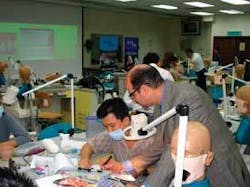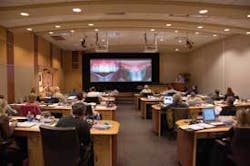CE with a driving purpose
by Nils Olson, DDS, FAACD, FAGD
After dental school I dutifully attended much more than my share of continuing education courses. Frankly, though, what I was exposed to versus what I actually implemented left a considerable gap. I quickly found that merely attending and completing a course did not guarantee that anything would radically change in my practice. The rigors and demands of running my practice often seemed to get in the way of how much I could apply.
But all that changed in 1995.
I remember when I first heard Frank Spear. It was at the Academy of General Dentistry annual meeting in Baltimore. I was impressed by his level of dentistry, clinical knowledge, and command of esthetic principles. In those few short hours, my professional life changed forever. I vowed to continue my studies with Dr. Spear, and provide my patients with that level of care.
Several months later, I was in Dr. Spear’s office in Seattle while attending an “Excellence in Esthetic Dentistry” session with 12 other dentists. Several of these dentists also had an impact on my career. Drs. Lynn Jones (Bellevue, Wash.), John Derango (La Salle, Ill.), and Derry Rogers (Melbourne, Australia) immediately struck me as dedicated and gifted. In addition, all three were Accredited members of the American Academy of Cosmetic Dentistry. When I asked each to suggest ways to help me advance and develop my skills even more, they answered in unison: “Join the AACD and pursue Accreditation. This will take you to another level.”
So I did. My first AACD meeting was in 1996 in San Diego. I heard speakers such as Drs. Jeff Morley and Jimmy Eubank. Their message only fueled my fire so I immediately signed up for the Accreditation track. But signing up and actually doing the work are two different things. This event signified the beginning of the continuing education journey of my life. It is one I have not regretted for a single moment. The AACD sets the standard for excellence in cosmetic dentistry through its accreditation process. Earning Accreditation requires a demonstration of proficiency in the art and science of cosmetic dentistry.
But my story is really about the many benefits of the learning, which formed my clinical foundation for Accreditation. Each candidate must present five cosmetic cases that fit within the criteria set by the academy. Successful treatment of these cases demands a level of knowledge encompassing a number of disciplines which are rarely, if ever, covered in undergraduate dental education. Accreditation requires one to become knowledgeable and skilled in areas such as dental materials, smile design, periodontics and periodontal plastic surgery, treatment planning and case management, dental anatomy, occlusion, and dental photography.
Great teachers
From that point forward, I was a whirlwind. I took courses with Drs. Spear, Eubank, and Morley, along with John Kois, Ross Nash, Buddy Mopper, Bob Nixon, and others. From these masters, I learned aspects of cosmetic dentistry I had only an inkling about previously.
What an exciting time this was - one of enthusiasm and passion for learning. It is said that when the student is ready, the teacher(s) will appear. Such was the case.
While the standards of Accreditation are exact, there are no restrictions on how each candidate can pursue learning. A dentist can walk down a variety of paths, choosing what works as one learns and grows. Whether choosing university-sponsored programs or those offered by private institutions, students are exposed to information and ideas that will hone and sharpen their skills.
Younger dentists with less clinical experience, but a ton of enthusiasm, are just as eligible to embrace continuing learning as are more mature dentists who are ready after years of practice. All are welcome at the table.
Putting together a CE plan to prepare for Accreditation focuses each dentist on learning and implementing new knowledge. Accredited member Dr. Betsy Bakeman, Grand Rapids, Mich., said, “The Accreditation process forced me to be more engaged in learning. The courses I chose were in areas in which I was experiencing challenges such as periodontal-plastic procedures, occlusion, and direct bonding. In taking courses, I didn’t allow myself to drift from the learning at hand. I had a want, desire, and need to master the information and skills that were presented. I became a giant sponge - open and receptive to information that would help me achieve the goal of Accreditation. At no other time in my career have I felt like I did when I was going through the Accreditation process.”
Learning with a purpose
Commitment to learning with a purpose leads more directly to implementation of clinical techniques than a more casual approach to continuing education or the mere collection of credits. As cosmetic techniques are implemented, they become more routine in daily practice. When exceptional techniques become commonplace, the standard for excellence will be raised, without an inordinate increase in stress.
Learning more sophisticated techniques when solving esthetic dilemmas allows one to satisfy patients’ clinical - and emotional - needs and desires. For years I treated patients with anterior fixed bridges with a ridge-lap type of pontic. The cases looked good at the time. But the satisfaction of learning how to properly develop a pontic site for an ovate pontic, which appears to be natural and growing out of the tissue rather than sitting on it, is incredibly satisfying professionally. That satisfaction is compounded by the patients’ delight. Occasionally, I deferred treatment until I was more skilled at approaching a more challenging problem. But often I didn’t delay long. Just as a challenging case would appear, the answer was delivered through my learning path. I sensed an urgency to master a broad spectrum of esthetic issues, which would solve a range of patients’ needs.
The hard things
In order to become an Accredited member of the AACD, a dentist must identify specific deficiencies and weaknesses in his or her cosmetic dental skills. Sometimes it’s a matter of not knowing what we don’t know.
One of the first opportunities for learning is through the AACD Accreditation workshops, two of which are required prior to case submission - the Accreditation and the criteria workshops. Attendees quickly learn to assess the level of skill that is required and whether that level is achievable, given their present level of knowledge.
Dr. John Merrill, from Charlevoix, Mich., enrolled in the cosmetic continuum at LSU to pursue his Accreditation.
“I falsely considered myself already quite exceptional in the area of cosmetic dentistry,” Merrill said. “But like tennis or golf, no matter how good a player you think you are becoming, you keep finding out there are so many levels above you. The first take-home lesson in Accreditation is to adopt an attitude of humility and understand that your ego could be your biggest enemy to success. The carefully crafted educational experience at LSU began as most courses do - lecture and then practice on dentaforms. Here is the distinction. You toil and slave over every last detail, then you have your life’s work scrutinized by the rest of the class. Later, instructors also scrutinize your work, if there is anything remaining. This is a good time to have thick skin because you stand to experience some of the greatest breakthroughs and epiphanies of your career.”
Developing one’s skills in cosmetic dentistry doesn’t always require enrollment in courses apart from the AACD. Dr. J.A. Reynolds, an Accredited member from Franklin, Tenn., is also a member of the visiting faculty at the L.D. Pankey Institute.
“What were the best courses leading toward Accreditation?” Reynolds asked. “It is simple for me. When I joined the AACD in 1994, I was already midway along the continuums at the Pankey Institute. At the institute, I learned why teeth look the way they do as they relate to dynamic function. The AACD dovetailed with the philosophy of practice I formed through the teachings of Dr. Pankey. The AACD showed me the nuts and bolts of bonding, porcelain, and smile design. That’s right. I acquired all the esthetic knowledge for Accreditation, both technical and didactic, through courses taken at the AACD annual meetings. Why is this important? It shows that the AACD is both inclusive and nurturing.”
What a great endorsement of the AACD’s Annual Scientific Session. In addition to the knowledge he had gained at the Pankey Institute, Dr. Reynolds was able to develop his skills while at the academy’s annual meetings to become Accredited.
The process of identifying areas of weakness and the degree of that weakness can be both enlightening and humbling. An honest assessment and coming to grips with the reality is what one must do.
As Dr. Eubank from Plano, Texas, said, “It’s not about being Accredited that’s important. It’s the dentist you become in order to be Accredited that’s important.”
In other words, it is about the process - not the endpoint.
The path to AACD Accreditation is challenging for sure. But the skills needed are achievable, and the teachers and resources to learn those skills are available. It is not about the destination. It is about the journey. The rewards reaped along the way are well worth it. We hope to see you on the path soon. We will be looking for you.Dr. Nils Olson earned his DDS from the Baltimore College of Dental Surgery, University of Maryland Dental School. His Frederick, Md., practice emphasizes cosmetic and restorative dentistry. He is an Accredited member and Fellow of the American Academy of Cosmetic Dentistry. Dr. Olson serves as an Accreditation and Fellowship examiner, and is a member of the Accreditation Committee of the AACD. He lectures on cosmetic dentistry. Reach him at [email protected].




